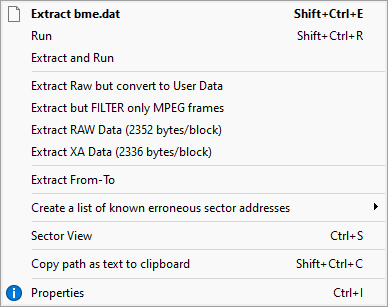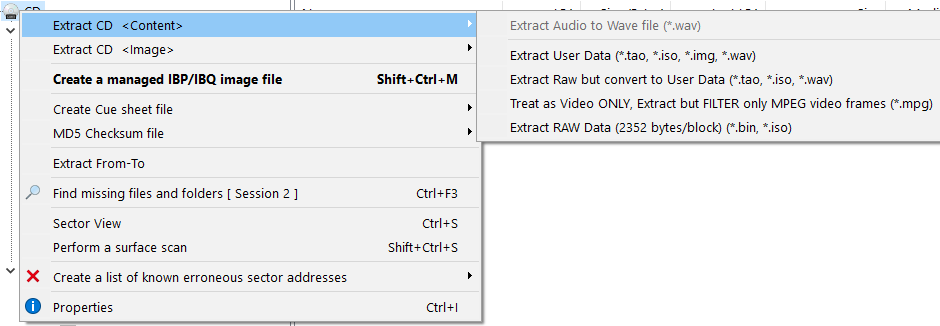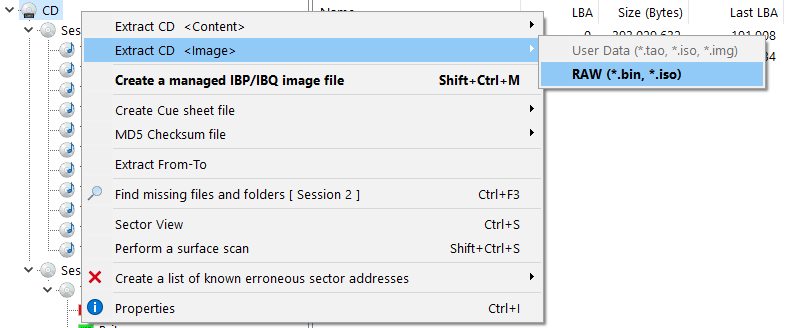Extractie opties
Extractie van een bestand, map, imagebestand, ... is eenvoudig! Selecteer gewoon het object dat u wilt extraheren, klik met de rechtermuisknop en kies Extractie. In de meeste gevallen is de beste keuze de optie die in vetstaat.
IsoBuster ondersteunt verschillende extractiemethoden die ook licht verschillen per object. Maar zoals gezegd, kies de Extractiemethode in vet en de kans is groot dat u krijgt wat u wilde.
Als u een beetje verward bent over de term 'extract', kunt u het ook zien als : Kopiëren van de CD, DVD of imagebestand naar een andere locatie (bijv. uw harde schijf)
Toch is het verstandig om dit minstens één keer door te lezen om de mogelijkheden te begrijpen.
Extractiemethoden :

Extract
Hiermee worden bestanden en mappen geëxtraheerd zoals ze bedoeld zijn.
Alleen het 'gebruikersdata' gedeelte per blok wordt opgeslagen in de bestanden, aangezien het apparaat is geïnstrueerd alleen deze data te leveren. Bestanden die op deze manier worden geëxtraheerd, kunnen worden geopend als normale bestanden. In sommige gevallen besluit IsoBuster daadwerkelijk 'Extract maar converteer naar gebruikersdata' te gebruiken, maar dit gebeurt naadloos en u hoeft zich hier geen zorgen over te maken.
Extract Gebruikersdata
Dit is eigenlijk exact hetzelfde mechanisme als beschreven in 'Extract'. (Zie hierboven)
Extract Raw maar converteer naar Gebruikersdata (alleen ondersteund op CD)
Deze methode zal alle blokken Rawextraheren. Dit betekent dat de CD drive niet alleen het gebruikersdata gedeelte per blok levert, maar ook het complete Raw-blok. IsoBuster (in plaats van de drive) zal vervolgens beslissen over de modus en het juiste gebruikersdata-gedeelte per blok extraheren.
De resulterende bestanden en mappen zullen hetzelfde zijn als wanneer u ze normaal zou extraheren ('Extract').
Extract maar filter alleen Mpg frames
Deze extractiemethode mag alleen worden gebruikt als u vermoedt dat bepaalde objecten Mpg-videodata sectorenbevatten, en als het de videodata is waar u naar op zoek bent. Dit soort videodata kan worden gevonden op VCD, SVCD, DVD en CD-i. Bijvoorbeeld, u kunt een *.dat-bestand van een Video CD op deze manier extraheren en eindigen met de pure mpg-videodata, zonder de overhead die Windows extraheert (als het al onder Windows werkt). Deze 'schone' video heeft u nodig als u de mpg-data wilt gebruiken voor uw eigen Video CD's.
Extract Raw (alleen ondersteund op CD)
Deze methode zal alle blokken Rawextraheren. In het geval van bestanden en mappen is deze keuze geen goed idee. De resulterende bestanden bevatten veel meer dan de daadwerkelijke bestandsdata en zullen corrupt lijken. Deze optie is uitsluitend bedoeld voor technische doeleinden. Bij extractie van imagebestanden wordt Raw veel interessanter en is in veel gevallen zelfs de voorkeursmethode.
Als u deze methode gebruikt in een Imagebestand, moet het imagebestand Raw worden opgenomen. Als het niet Raw is opgenomen, wordt deze optie uitgeschakeld. DVD's hebben slechts één type blokken en bevatten alleen gebruikersdata (er bestaat geen Raw DVD-data). Dus bij DVD is deze optie uitgeschakeld.
Extract XA (alleen ondersteund op CD Mode 2 Data)
Deze methode werkt alleen op Mode 2 (M2) tracks of bestanden in die tracks. Datatracks op CD komen in twee soorten, Mode 1 en Mode 2. Er bestaat geen XA (2336 bytes per blok) voor Mode 1, alleen voor Mode 2. Zie Track- en sectormodi voor meer informatie.
Bepaalde platforms / formaten slaan data op in zowel M2F1- als M2F2-blokken (CD-i, VCD, PSX, ..). Omdat het vooraf onmogelijk is te weten welk blok welke vorm heeft, wordt het niet ongebruikelijk geacht 2336 bytes per blok te gebruiken in bepaalde bestandsformaten. Door de subheader per blok mee te nemen, kan een toepassing zien wat de Form is per blok (1 of 2). Bepaalde bestandsformaten afkomstig van PSX, CD-i enz. (bijv. *.xa, *.rtf, enz.) gebruiken deze vorm.
Deze extractiemethode wordt alleen weergegeven wanneer de track waarin het bestand zich bevindt Mode 2 is, of wanneer de track waarvan u een image maakt Mode 2 is, of wanneer de sessie of CD die u extraheren wilt (image of inhoud) alleen Mode 2-tracks bevat.
Uitvoeren
Werkt alleen als u één enkel bestand selecteert. Dat bestand wordt geëxtraheerd naar de systeemtempmap (bijv. C:\Windows\Temp) en daar uitgevoerd. Dit betekent ook dat als u een uitvoerbaar bestand (bijv. Setup.exe) draait dat extra bestanden vanaf het medium of Imagebestand (bijv. dll's) nodig heeft, deze ook naar dezelfde map moeten worden geëxtraheerd.
Extractie en Uitvoeren
Extractie en Uitvoeren is eigenlijk hetzelfde als Uitvoeren, behalve dat u eerst de locatie kunt kiezen.
Extractie van ALLE bestanden en mappen (directories)
Mogelijk heeft IsoBuster meerdere Bestandsystemengevonden en waarschijnlijk wijzen ze allemaal naar exact dezelfde bestanden en mappen. Lees het gedeelte over de verschillende Bestandsystemen om uw keuze te maken. (Kortom, de iconen direct verbonden aan de track / Partition iconen zijn Bestandsystemen.
Als u alle bestanden en mappen van een medium wilt extraheren, begint u het beste bij het bestandsysteem van uw keuze. Klik met de rechtermuisknop en kies Extractie. Extractie (in vet) is de beste keuze!
Extractie van geselecteerde bestanden en/of mappen (directories)
Selecteer de bestanden en/of mappen die u wilt extraheren en kies Extractie (Extractie-optie in vet). Om meer dan één object tegelijk te selecteren, selecteert u ze in de ListView aan de rechterkant. In de TreeView aan de linkerkant kunt u slechts één object tegelijk selecteren.

Extractie van een Track of Partition
De enige echte goede reden om een track te extraheren is om een audiotrack naar een wave (*.wav) bestand te extraheren. Deze extractiemethode haalt het gebruikersdata-gedeelte uit elk blok maar voor audio is dit eigenlijk exact hetzelfde als Raw-extractie. Een wave-bestand is een raw audiotrack met een kleine header aan het begin van het bestand. Als u 'Extract Raw' selecteert, krijgt u hetzelfde bestand maar zonder de kleine header aan het begin.
Voor datatracks is het verhaal anders en behalve voor technische doeleinden is er weinig nut om geëxtraheerde datatracks naar een imagebestand te zetten.
Voor optische media (CD, DVD en BD) extracten het gebruikersdata-gedeelte zal precies dat extraheren naar eenn *.iso bestand. In de meeste gevallen zal eenn *.iso bestand dan 2048 bytes per blok bevatten. Extract Raw zal extraheren naar een *.bin-bestand en alle blokken zullen 2352 bytes bevatten. Extractie maar filter M2F2 Mpg-blokken zal een track scannen en alle videoblokken filteren (bijv. op VCD, SVCD en CD-i). Deze optie is handig wanneer het Bestandsysteem van een VCD, SVCD en CD-i beschadigd is, maar u de videodata van de tracks wilt terughalen.
Voor Partities kan het soms handig zijn om alleen de partitie als image te extraheren, omdat een partitie-image, anders dan een track- of sessie-image, zelfstandig kan worden aangekoppeld met IsoBuster of andere tools.
Extractie van een Sessie
Een sessie extraheren kan op twee manieren: Extractie van de Inhoud <Content> of Extractie naar een Image Bestand <Image>. Net als bij het extraheren van een Track zijn er maar een paar goede redenen om een sessie te extraheren en als u geen expert bent, zou ik het niet doen.
<Inhoud>
Hiermee worden alle Tracks in deze sessie één voor één geëxtraheerd, met de Extractiemethode van uw keuze. Lees het vorige onderwerp 'Extractie van een Track' om te zien wat dat per track betekent. De enige goede reden om dit te kiezen is als u alle audiotracks van een sessie naar wave (*.wav) bestanden wilt extraheren.
<Image>
Hiermee wordt een Sessie geëxtraheerd naar een Imagebestand. Alleen bij technische vaardigheden is dit echt een goed idee. Het resulterende Imagebestand bevat de blokken vanaf het eerste blok van de eerste track van deze sessie tot het laatste blok van de laatste track van deze sessie. Om een extractiekeuze te maken, kijkt u in het volgende onderwerp 'Extractie van een CD of DVD'

Extractie van een CD of DVD
<Inhoud> (Alle sessies en tracks worden afzonderlijk geëxtraheerd, één voor één)
Dit is vergelijkbaar met <Inhoud>-extractie van een sessie. Hiermee worden alle Tracks op de CD of DVD of uit het Imagebestand één voor één geëxtraheerd, met de Extractiemethode van uw keuze. Lees het vorige onderwerp 'Extractie van een Track' om te zien wat dat per track betekent. De enige goede reden om dit te kiezen is als u alle audiotracks van een sessie naar wave (*.wav) bestanden wilt extraheren.
<Image> (HET Imagebestand-creatiehulpmiddel)
Dit is HET de optie als u een Imagebestand van uw CD, DVD wilt maken of als u het Imagebestand naar een ander formaat wilt converteren. Deze extractiemethode zal alle blokken extraheren, van het allereerste tot het allerlaatste blok, van uw CD, DVD of Imagebestand.
In het geval van een normale data-CD (bijv. een Windows-installatieschijf) is het waarschijnlijk een goed idee om alleen de gebruikersdata te extraheren. Wanneer u echter vermoedt dat er ook andere modi op de CD zijn (bijv. Audio, M2F2 (bijv. VCD, SVCD en CD-i), ...) is het beter om Rawte extraheren. Dus in zekere zin is het waarschijnlijk altijd het beste om een Imagebestand raw te extraheren!
ISO-imagebestanden zijn erg populair, maar ze komen in veel verschillende formaten en sommige schrijfprogramma's ondersteunen ze allemaal, terwijl sommige kieskeurig zijn in hun keuze.
Als u een image raw extraheert, maakt u imagebestanden die compatibel zijn met de meerderheid van de schrijfprogramma's! Het resulterende *.bin-bestand kan eenvoudig worden hernoemd naar een *.iso-bestand. Ja, *.bin-bestanden en *.iso-bestanden zijn vaak exact hetzelfde !! Alleen (voor zover ik weet) accepteert Roxio Creator geen raw *.iso-bestanden. In dat geval is het beter om het imagebestand alleen naar gebruikersdata te extraheren en het resulterende *.tao-bestand te hernoemen naar een *.iso-bestand.
Het converteren van imagebestanden naar *.iso is exact hetzelfde. Extract Raw naar *.bin (=*.iso) en alle image-overhead wordt gestript tot de Raw-essentie. Extracteer alleen gebruikersdata als u wilt converteren voor Roxio Creator en hernoem naar *.iso.
Als de Extract Raw-optie is uitgeschakeld, betekent dit dat de bron (DVD of Imagebestand) geen raw-extractie toestaat. De redenen zijn eenvoudig. DVD kent alleen 2K-blokken(2048 bytes gebruikersdata) per blok zonder overhead. Er bestaan geen Audio- of Videoblokken op DVD. Imagebestanden kunnen alleen 'gebruikersdata' bevatten en kunnen logischerwijs niet rawworden geëxtraheerd, omdat ze alleen de gebruikersdata bevatten.
Extractie van een Harde Schijf, SSD, Flash Drive, SD-kaart, ...
<Inhoud> (Alle Partities worden afzonderlijk geëxtraheerd, één voor één naar *.img-bestanden)
<Image> (HET Imagebestand-creatiehulpmiddel)
Dit is HET de optie als u een Imagebestand van uw gehele harde schijf of USB-stick wilt maken of als u het Imagebestand naar een ander formaat wilt converteren. Deze extractiemethode zal alle blokken extraheren, van het allereerste tot het allerlaatste blok van het medium.
Extractie Van - Tot
Extractie Van - Tot is een technisch hulpmiddel en maakt het mogelijk blokken naar keuze te extraheren. Het is een krachtige functie als u in de techniek zit. Als u alleen data wilt extraheren (Imagebestanden of bestanden en mappen), is dit niet zo nuttig.
Fouten : Zie 'Fouten tijdens Extractie'